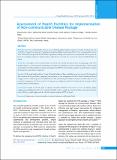Please use this identifier to cite or link to this item:
https://hdl.handle.net/20.500.14356/1549Full metadata record
| DC Field | Value | Language |
|---|---|---|
| dc.contributor.author | Aryal, Binod Kumar | - |
| dc.contributor.author | Daud, Mohammad | - |
| dc.contributor.author | Thapa, Ambika | - |
| dc.contributor.author | Mahotra, Anita | - |
| dc.contributor.author | Magar, Sudip Ale | - |
| dc.contributor.author | Malla, Chandra Kumari | - |
| dc.date.accessioned | 2023-05-16T05:38:54Z | - |
| dc.date.available | 2023-05-16T05:38:54Z | - |
| dc.date.issued | 2018 | - |
| dc.identifier.citation | AryalB. K., DaudM., ThapaA., MahotraA., Ale MagarS., & MallaC. K. (2018). Assesssment of Health Facilities for Implementation of Non-communicable Disease Package. Journal of Nepal Health Research Council, 16(2), 149-155. https://doi.org/10.33314/jnhrc.v16i2.1100 | en_US |
| dc.identifier.issn | Print ISSN: 1727-5482; Online ISSN: 1999-6217 | - |
| dc.identifier.uri | http://103.69.126.140:8080/handle/20.500.14356/1549 | - |
| dc.description | Original Article | en_US |
| dc.description.abstract | Abstract Background: Non-communicable Diseases are an alarming public health emergency in Nepal. Owing to the risk of NCD’s in Nepal, Government of Nepal has developed a Multisectoral Action Plan for Non-communicable Disease 2014-2020 and has adopted the World Health Organization Package of Essential Non-communicable Disease protocol. Prior for its implementation in Nepal, baseline study has been carried out to assess the status of health facilities in Nepal. Methods: A descriptive cross-sectional study was carried out in Kailali and Ilam district encompassing a total of 92 health facilities. A set of structured questionnaire and interview guideline was used to obtain the data. Collected data was transferred to Microsoft Excel, cleaned and analyzed in SPSS 16.0. Descriptive analysis was performed to express the frequencies and relative frequencies Results: Of the total health facilities, 49 and 43 health facilities of Ilam and Kailali were interviewed. The hospital of Ilam consisted all the procedure, equipment and medicine for the management of NCDs whilst, health posts lacked Oxygen services. Only 592 posts were fulfilled out of 704 sanctioned post in both the districts of which only 161 were trained in management of NCDs. Atotal of 231 patients were diagnosed with NCDs before the day of study in all the health facilities of both districts. Conclusions: Study reveals the gaps in capacity of health institution and system in terms of training, supply, equipments, and diagnostics. However, training of health workers, supply of essential medicines and improvising the service delivery would supplement the effective implementation of PEN in Nepal. Keywords: Bupivacaine; dexmedetomidine; intrathecal adjuvant; saddle spinal block. | en_US |
| dc.language.iso | en | en_US |
| dc.publisher | Nepal Health Research Council | en_US |
| dc.relation.ispartofseries | Apr-June, 2018;1100 | - |
| dc.subject | Bupivacaine | en_US |
| dc.subject | Dexmedetomidine | en_US |
| dc.subject | Intrathecal adjuvant | en_US |
| dc.subject | Saddle spinal block | en_US |
| dc.title | Assesssment of Health Facilities for Implementation of Non-communicable Disease Package | en_US |
| dc.type | Journal Article | en_US |
| local.journal.category | Original Article | - |
| Appears in Collections: | Vol. 16 No. 2 Issue 39 Apr-Jun 2018 | |
Files in This Item:
| File | Description | Size | Format | |
|---|---|---|---|---|
| 1100-Manuscript-5281-1-10-20180703.pdf | Fulltext Download | 218.09 kB | Adobe PDF |  View/Open |
Items in DSpace are protected by copyright, with all rights reserved, unless otherwise indicated.
